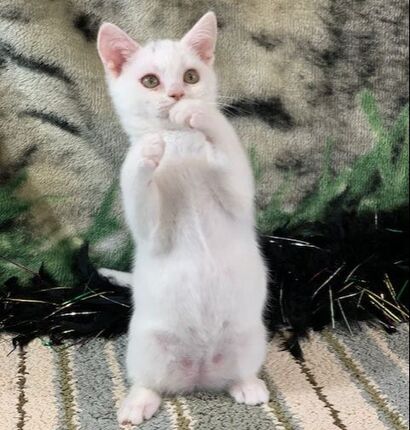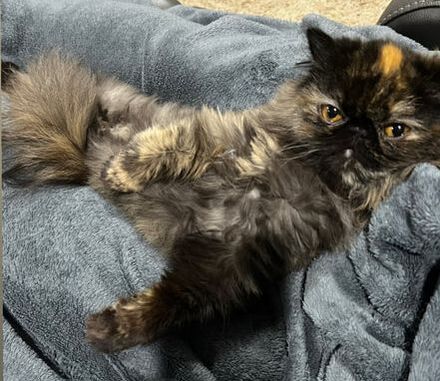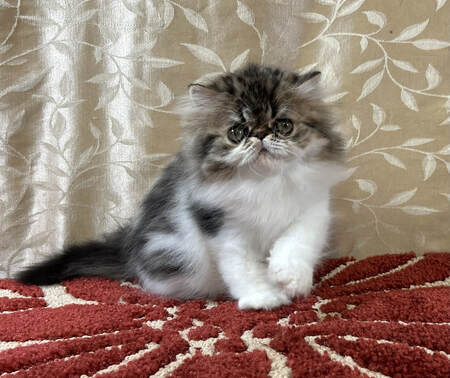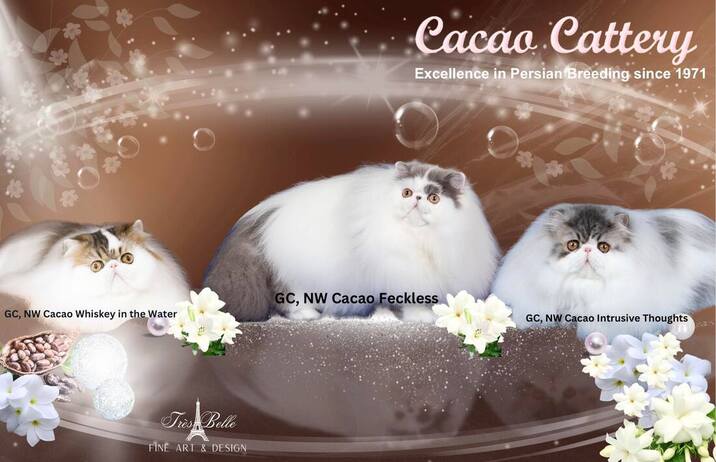Available Cats & Kittens
Available KittensThese healthy, happy, and well-socialized kittens are all at least 12 weeks of age to ensure they are ready to transition to a new home.
To see our available kittens (click here) or Cacao Cattery | Facebook |
Available AdultsWe always try to keep in mind what's best for our cats, and sometimes that means letting go of adults who have been with us for a while. These retired adults are available to approved homes who will give them a wonderful retirement full of love and spoiling.
To see our available retired adults .... (click here) |
Available Breeder & Show CatsThese cats have exceptional qualities that make them worthy of the show ring or as an excellent breeding cat to advance the breed.
To see our available show & breeder cats/kittens.....(click here) |
A Few Frequently Asked Questions
What is the difference between pet, breeder, and show quality cats?
The answer to this question will vary from breeder to breeder, but here is our answer.
Pet quality cats are cats that do not meet the written standard in some way and/or have some fault that would not make them a good cat for a breeding program. In many cases, they are nice quality cats, but they aren't "good enough" to be kept whole and to contribute to a breeding program. We strongly believe that only the best cats should be used in breeding programs - the rest make wonderful pets for people to own, be owned by, and loved. (Which is why it's very important to us to have sweet-natured cats, as well as healthy lines). Just because a cat is "pet quality," it does not mean they are 2nd class "kittycats" - just that they are not what the written standard calls for, so they shouldn't be used for breeding.
Breeder quality cats are, to us, cats with no major faults, but over all have something to add to a breeding program. Oftentimes, cats that we feel are "breeder" quality can be shown and even win some at shows, but they are not the level we consider to be "show quality."
Show quality cats are, to us, cats that are clearly superior, in terms of the meeting the written standard. They will possess a number of good traits and no major faults. They are cats that, when presented in good condition, can win and win often. They cannot just have good "looks", but they must also be cats of vigorous health and good temperaments.
The answer to this question will vary from breeder to breeder, but here is our answer.
Pet quality cats are cats that do not meet the written standard in some way and/or have some fault that would not make them a good cat for a breeding program. In many cases, they are nice quality cats, but they aren't "good enough" to be kept whole and to contribute to a breeding program. We strongly believe that only the best cats should be used in breeding programs - the rest make wonderful pets for people to own, be owned by, and loved. (Which is why it's very important to us to have sweet-natured cats, as well as healthy lines). Just because a cat is "pet quality," it does not mean they are 2nd class "kittycats" - just that they are not what the written standard calls for, so they shouldn't be used for breeding.
Breeder quality cats are, to us, cats with no major faults, but over all have something to add to a breeding program. Oftentimes, cats that we feel are "breeder" quality can be shown and even win some at shows, but they are not the level we consider to be "show quality."
Show quality cats are, to us, cats that are clearly superior, in terms of the meeting the written standard. They will possess a number of good traits and no major faults. They are cats that, when presented in good condition, can win and win often. They cannot just have good "looks", but they must also be cats of vigorous health and good temperaments.
I've read that I should tour the cattery that my kitten was raised in, as well as see the parents, is this true?
This is one major area we tend to detour from the commonly accepted "Guide to Buying A New Kitten" that are written in books and the internet. We do not give cattery visits/tours to those that come to our house to see our kittens. We feel this is, to be succinct, an invasion of our privacy and a risk to our safety. But there are a number of other reasons why we do not give "tours."
If you are able to visit a breeder in their home, take time to inspect the kittens/cats you do see. They should be clean and healthy, as well as perky (though they might be somewhat hesitant at first meeting you.) You should expect that the parts of the home you are able to see should be cleaned and neat. Since the breeder knew you were coming, they should have taken the time to neaten/clean up the public areas. If the house is dirty for a visit, you can imagine when guests are not expected, it would probably be far worse. There should be no strong odors, but it's likely that some cat might have just used the litterbox and some slight odor might be detected. But if you feel like the smell is going to knock you out, it is probably not the best idea to purchase a kitten from that location.
This is one major area we tend to detour from the commonly accepted "Guide to Buying A New Kitten" that are written in books and the internet. We do not give cattery visits/tours to those that come to our house to see our kittens. We feel this is, to be succinct, an invasion of our privacy and a risk to our safety. But there are a number of other reasons why we do not give "tours."
- Many "pet buyers" often plan their day visiting a number of catteries. They do not take the time to change clothes and/or wash their hands between catteries. Thus, any possible contagion they might have picked up at the preceeding catteries could be spread to our entire population in a matter of minutes. The kittens we show to them for sale are generally kept isolated from the rest of our cats for that reason.
- Many people do not understand that catteries with more than one male require some cats to be confined. Thus, when they see a cat in an enclosure, they might be perplexed. Enclosures, in themselves, are not an evil thing. There are a number of reasons a cat must be confined at times for their own health and well-being, including but not limited to:
- Keeping whole males separate from females so that cats do not mate indiscriminately
- Keeping whole males separate from kittens (whole males can kill or severely maim a kitten if they try to breed it. Some whole males see any other cat as a potential mate, including kittens.)
- Keeping litters of kittens separate until fully vaccinated. Just like toddlers in a daycare, kittens can spread infections faster than wildfire. And this can be deadly to the kittens.
- Keeping heavily pregnant females from jumping off cat trees or high places and harming themselves or their unborn
- Monitoring the food intake and waste output of a cat that might be "off" their food or weight
- Keeping show cats separate from the rest of the cats upon a return from a show hall (as they can bring home viruses/bacteria/other contagions from the shows)
- That being said, enclosures should be large enough that the cat move around, preferably have shelves as well as floor space. CFA recommends 24 square feet of floor for each cat. Floor space is more important than vertical space - so called "tokyo cages" that have a very tiny floor and a number of shelves are actually very poor enclosures for cats.
- It's not unreasonable to ask to see the parents, but keep in mind it might not always be possible.
- In the past, breeders who showed their entire cattery to strangers (people who were looking to buy) later had their houses broken into - and the most valuable cats stolen (as the breeders had shown them exactly where the find the cats.) (ASIDE: Some breeders no longer will even allow people into their houses at all due to fear of theft/robbery.. which is sadly now becoming a common trend.)
- Finally, we feel that our house is still a private residence. We are not a business, and even if we were, no business would let you see their entire premises.
If you are able to visit a breeder in their home, take time to inspect the kittens/cats you do see. They should be clean and healthy, as well as perky (though they might be somewhat hesitant at first meeting you.) You should expect that the parts of the home you are able to see should be cleaned and neat. Since the breeder knew you were coming, they should have taken the time to neaten/clean up the public areas. If the house is dirty for a visit, you can imagine when guests are not expected, it would probably be far worse. There should be no strong odors, but it's likely that some cat might have just used the litterbox and some slight odor might be detected. But if you feel like the smell is going to knock you out, it is probably not the best idea to purchase a kitten from that location.
Do you breed "Teacup," "Doll Face," "Rug Hugger," etc...?
We breed for the established Persian standard, which is not the so-called "doll face", "tea cup," or "rug hugger" (or any other associated terms). A little history about those terms.. they are marketing gimmicks created by kitten mills. These are also sometimes referred to as "backyard breeders" - not because they actually have their cats in their backyards, but because they care little for genetics, health standards, or breed standards. They simply breed to make money. They made up these terms (and others) to try market their often poorly bred non-standard kittens, and unfortunately it has led many to believe these are actually accepted terms in the professional and reputable breeding community (they are not.) Many do not register their cats, and often will market their kittens at a very young age to maximize profit (below the age of 10 weeks).
That being said, we do sometimes get kittens we lovingly refer to as "throw backs" - very long noses compared to the Persian standard! We also sometimes have kittens that are smaller than the Persian standard (which calls for a large to medium cat, 8-12 lbs at least).
If you are really set on a non-standard look, please be careful with your selection of a breeder. While some of the off-standard breeders are diligent in their genetic testing (for PKD) and keep their animals healthy and well-cared for, others simply breed whatever and pay no attention to anything other than what they can sell. We do not make any recommendations for these types of breeders who are deliberately breeding for profit, as we do not know any of them personally and do not agree with their breeding philosophy. We do recommend to those that prefer a different look than standard bred Persians to consider similar breeds such as the Ragdoll, Ragamuffin, Norwegian Forest Cat, and Birman. These are all beautiful breeds that might be just what you are lookig for!
We breed for the established Persian standard, which is not the so-called "doll face", "tea cup," or "rug hugger" (or any other associated terms). A little history about those terms.. they are marketing gimmicks created by kitten mills. These are also sometimes referred to as "backyard breeders" - not because they actually have their cats in their backyards, but because they care little for genetics, health standards, or breed standards. They simply breed to make money. They made up these terms (and others) to try market their often poorly bred non-standard kittens, and unfortunately it has led many to believe these are actually accepted terms in the professional and reputable breeding community (they are not.) Many do not register their cats, and often will market their kittens at a very young age to maximize profit (below the age of 10 weeks).
That being said, we do sometimes get kittens we lovingly refer to as "throw backs" - very long noses compared to the Persian standard! We also sometimes have kittens that are smaller than the Persian standard (which calls for a large to medium cat, 8-12 lbs at least).
If you are really set on a non-standard look, please be careful with your selection of a breeder. While some of the off-standard breeders are diligent in their genetic testing (for PKD) and keep their animals healthy and well-cared for, others simply breed whatever and pay no attention to anything other than what they can sell. We do not make any recommendations for these types of breeders who are deliberately breeding for profit, as we do not know any of them personally and do not agree with their breeding philosophy. We do recommend to those that prefer a different look than standard bred Persians to consider similar breeds such as the Ragdoll, Ragamuffin, Norwegian Forest Cat, and Birman. These are all beautiful breeds that might be just what you are lookig for!




